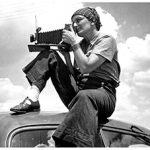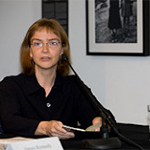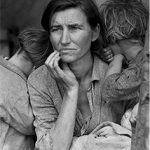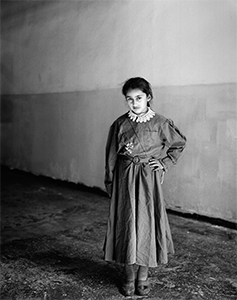Barbican Exhibition Summer 2018
Two female photographers from different eras, both working on long term politically motivated documentary projects, and achieving their aims through a series of situational portraits. Downstairs, Dorothea Lange’s “Politics of Seeing”; upstairs Vanessa Winship’s “And Time Folds.”

Dorothea Lange is one of the most important photographers in the history of the art, if only for her Migrant Mother image, which became an icon of the American Depression in the 1930’s and remains one of the most recognizable photographs of all time. Although “The Politics of Seeing” exhibition has one section entirely devoted to the Migrant Mother series, and another to the depression era images for which she is best known, it aims to give a much broader view of her work over her entire lifetime. Arranged chronologically, it covers her early work as a portrait photographer to the rich and famous in San Francisco; her work documenting the internment of Japanese American citizens during WWII; and various projects after the war associated with civil rights and environmental concerns.

Vanessa Winship is a contemporary photographer from the north of England who rose to fame in 2011 as the first woman to win the Foundation Henri Cartier-Bresson award. The award enabled her to travel across the USA and create her most notable work to date, “She Dances on Jackson”, which documents the lives of the invisible middle American working class. Like Lange, much of her work is politically motivated and seeks to raise awareness of dispossessed and marginalized communities. Her exhibition “And Time Folds” is again organised chronologically with her early work made in Eastern Europe, including the Balkans and Turkey, telling the story of today’s desperate populations. Then, closer to home, her minimalist landscapes show the harsh bleakness of the north of England.
My objective with this post is to encourage anybody who hasn’t been, to go. Barbican exhibitions tend to be for quite short periods, so be quick!
If you’ve been and disagree with me, I would love to hear from you, either through the comments box below or through the social media channel of you choice right.
Dorothea Lange: “The Politics of Seeing”
The exhibition starts with portraits made by Lange in her successful, up-market studio in San Francisco, where the other experimental photographers and Californian Modernists such as Ansel Adams, Imogen Cunningham and Edward Weston would “often hang out after hours.” 1919-34 were boom years for Lange, who enjoyed the social and financial benefits of having “the cream of the trade.” As she put it herself, “she was the person you came to, if you could afford it.”
The images, generally 6×8 high contrast monochromes of single sitters, often with large areas blown to black or white, apparently show a pictorialist style with hints of emerging modernism.
Politically though, Lange felt motivated to take her bulky camera equipment to the street to capture the impact of the depression on the working class communities of the city, shooting, amongst other things, lines for bread handouts. It was these images that drew her to the attention of the Farm Security Administration (FSA) who awarded her the commission to document the impact of the depression on the rural farming community. The goal was to create images that could raise public awareness of this suffering caused to these people, to a point where it could never happen again.
Visual Version of John Steinbeck
Steinbeck wrote “The Grapes of Wrath”, Lange shot “The Migrant Mother”, and the exhibition asserts that the two knew each other. They clearly shared a common concern for the humanitarian crisis occurring in the farming communities as a result of both the great depression and major drought.
Technically, Lange employed and perhaps innovated some distinct compositional techniques such as concentrating isolated limbs. An abstraction that conveys more emotion than a depiction of the whole. In a series, for example, one image may show just hands; the next, back and neck; and another, feet.
Multiple Versions of the Migrant Mother

Luck was a major factor in the creation of this, one of the most important photographic images of all time. Lange was employed at the time by the FSA, to document the effect of the depression in rural areas, One evening she was driving back from an assignment when she spotted a camp for migrant pea farmers and was drawn to them “as if by a magnet.”
Although Lange usually took time to build a relationship with her subjects, she made all five exposures for the Migrant Mother within a few minutes of meeting, Florence Thompson, a desperate, 32 year old mother of seven. Each successive image draws closer to Thompson, both optically and emotionally.
Point of trivia: the original version of the Migrant Mother shows Thompson’s thumb clenched tightly round a tent pole in the bottom right of the image. Lange was unhappy about this, presumably as an aesthetic distraction, and had it removed (minimized), post-processing as it were, in later versions. However, having seen the original, I cannot help but recognize the thumb, still there in a ghostly form.
Later Projects
“The New California”, “Public Defender” and “Death of a Valley” constitute over half of the exhibition and introduce the visitor to Lange’s later work covering civil rights and environmental concerns.
Vanessa Winship: “And Time Folds”
As with the Lange exhibition, “And Time Folds” is a series of projects presented chronologically.

Imagined States and Desires: A Balkan Journey
This series was shot between 1999 and 2003, with Winship travelling constantly between Albania and Kosovo. This was a time, immediately following the Kosovo war, of political uncertainty and civil unrest in the Balkan Peninsular. Formerly part of the Socialist Federal Republic of Yugoslavia, much of the region is steeped in communist culture and history. Whereas the economic disappointment and lack of law and order provided fertile ground for extreme right-wing and anti-western sentiment.
The mass migration as more than 600,000 ethnic Albanians returned to Kosovo in what is believed to be the fastest refugee return is history, alongside 200,000 Serb civilians moving to Serbia and Montenegro, immediately following the end of the Kosozo war directly parallels Lange’s coverage of the Oakie influx into California.
Apparently exploring the concepts of “borders, land, memory, desire, identity and history” Winship eschews the standard photojournalistic approach of focusing on events themselves in favour of the less direct study of the impact on the civilian population. Through a combination of posed portraits and images of bombed-out buildings, the series chronicles the relatively recent conflict in this region on the periphery of Europe.
“She Dances on Jackson”
Winship’s most famous series, is an attempt to document the lives of the “ordinary” people who are swept along by the repercussions of distant events. Shot between 2011 and 2012, rural America was suffering: the after-effects of the 2008 recession; the irrelevant optimism of the Barack Obama presidency; and the rise in racial tension which led to the #BlackLivesMatter movement.
The subject matter the project has many parallels with Lange’s depression era work for the Farms Security Administration. Further commonality is in the execution of the project, largely as a series of black and white, posed portraits with a few urban landscapes.
Shot in the USA but tackling universal issues that resonates throughout the world.
Humber
This section of the exhibition consists of a series of bleak semi-abstract landscapes the capture the “relentless aching flatness and restrained beauty” of the Humber estuary.
Barton-upon-Humber is Winship’s hometown and the work meditates on the slow changes that have resulted from the building of the Humber Bridge since her childhood. Specifically, the impact on the environment and on the community previously dominated by the provision of a ferry service across the estuary. Both now largely bypassed.
To see more posts on other photographic topics, or to follow my learning progress, please like or follow me on the social media channel of your choice to the right.
The photographs reproduced in this post are the work of the credited artists. It is my intention to respect the copyright associated with these images in line with the Fair Use principle. Wherever possible I have acknowledged the author and/or reproduced Copyright information, and linked the image to either my source, when available, or the artists own website.